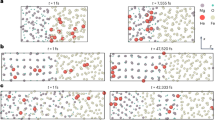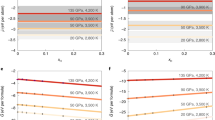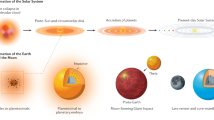Abstract
Recent palaeomagnetic observations1 report the existence of a magnetic field on Earth that is at least 3.45 billion years old. Compositional buoyancy caused by inner-core growth2 is the primary driver of Earth’s present-day geodynamo3,4,5, but the inner core is too young6 to explain the existence of a magnetic field before about one billion years ago. Theoretical models7 propose that the exsolution of magnesium oxide—the major constituent of Earth’s mantle—from the core provided a major source of the energy required to drive an early dynamo, but experimental evidence for the incorporation of mantle components into the core has been lacking. Indeed, terrestrial core formation occurred in the early molten Earth by gravitational segregation of immiscible metal and silicate melts, transporting iron-loving (siderophile) elements from the silicate mantle to the metallic core8,9,10 and leaving rock-loving (lithophile) mantle components behind. Here we present experiments showing that magnesium oxide dissolves in core-forming iron melt at very high temperatures. Using core-formation models11, we show that extreme events during Earth’s accretion (such as the Moon-forming giant impact12) could have contributed large amounts of magnesium to the early core. As the core subsequently cooled, exsolution7 of buoyant magnesium oxide would have taken place at the core–mantle boundary, generating a substantial amount of gravitational energy as a result of compositional buoyancy. This amount of energy is comparable to, if not more than, that produced by inner-core growth, resolving the conundrum posed by the existence of an ancient magnetic field prior to the formation of the inner core.
This is a preview of subscription content, access via your institution
Access options
Subscribe to this journal
Receive 51 print issues and online access
$199.00 per year
only $3.90 per issue
Buy this article
- Purchase on Springer Link
- Instant access to full article PDF
Prices may be subject to local taxes which are calculated during checkout



Similar content being viewed by others
References
Tarduno, J. A. et al. Geodynamo, solar wind, and magnetopause 3.4 to 3.45 billion years ago. Science 327, 1238–1240 (2010)
Nimmo, F. in Treatise on Geophysics 2nd edn, Vol. 8 (ed. Olson, P. ) 27–55 (Elsevier, 2015)
Lister, J. R. & Buffett, B. A. The strength and efficiency of thermal and compositional convection in the geodynamo. Phys. Earth Planet. Inter. 91, 17–30 (1995)
Labrosse, S., Poirier, J. P. & LeMouel, J. L. On cooling of the Earth’s core. Phys. Earth Planet. Inter. 99, 1–17 (1997)
Gubbins, D., Alfe, D., Masters, G., Price, G. D. & Gillan, M. J. Can the Earth’s dynamo run on heat alone? Geophys. J. Int. 155, 609–622 (2003)
Labrosse, S. Thermal evolution of the core with a high thermal conductivity. Phys. Earth Planet. Inter. 247, 36–55 (2015)
O’Rourke, J. G. & Stevenson, D. J. Powering Earth’s dynamo with magnesium precipitation from the core. Nature 529, 387–389 (2016)
Ringwood, A. E. Chemical evolution of terrestrial planets. Geochim. Cosmochim. Acta 30, 41–104 (1966)
Rubie, D. C., Melosh, H. J., Reid, J. E., Liebske, C. & Righter, K. Mechanisms of metal-silicate equilibration in the terrestrial magma ocean. Earth Planet. Sci. Lett. 205, 239–255 (2003)
Wood, B. J., Walter, M. J. & Wade, J. Accretion of the Earth and segregation of its core. Nature 441, 825–833 (2006)
Badro, J., Brodholt, J. P., Piet, H., Siebert, J. & Ryerson, F. J. Core formation and core composition from coupled geochemical and geophysical constraints. Proc. Natl Acad. Sci. USA 112, 12310–12314 (2015)
Hartmann, W. K. & Davis, D. R. Satellite-sized planetesimals and lunar origin. Icarus 24, 504–515 (1975)
Labrosse, S., Hernlund, J. W. & Coltice, N. A crystallizing dense magma ocean at the base of the Earth’s mantle. Nature 450, 866–869 (2007)
Buffett, B. A., Garnero, E. J. & Jeanloz, R. Sediments at the top of Earth’s core. Science 290, 1338–1342 (2000)
Stevenson, D. Core exsolution: a likely consequence of giant impacts and a likely energy source for the geodynamo. Eos Trans. AGU 88 (Fall Meet. Suppl.), abstr. U21D-02 (American Geophysical Union, 2007)
Buffett, B. A. Earth’s core and the geodynamo. Science 288, 2007–2012 (2000)
Wahl, S. M. & Militzer, B. High-temperature miscibility of iron and rock during terrestrial planet formation. Earth Planet. Sci. Lett. 410, 25–33 (2015)
Nimmo, F. in Treatise on Geophysics 2nd edn, Vol. 9 (ed. Stevenson, D. J. ) 201–219 (Elsevier, 2015)
Canup, R. M. Forming a Moon with an Earth-like composition via a giant impact. Science 338, 1052–1055 (2012)
Cuk, M. & Stewart, S. T. Making the Moon from a fast-spinning earth: a giant impact followed by resonant despinning. Science 338, 1047–1052 (2012)
Deguen, R., Landeau, M. & Olson, P. Turbulent metal-silicate mixing, fragmentation, and equilibration in magma oceans. Earth Planet. Sci. Lett. 391, 274–287 (2014)
Aubert, J., Labrosse, S. & Poitou, C. Modelling the palaeo-evolution of the geodynamo. Geophys. J. Int. 179, 1414–1428 (2009)
Badro, J., Cote, A. S. & Brodholt, J. P. A seismologically consistent compositional model of Earth’s core. Proc. Natl Acad. Sci. USA 111, 7542–7545 (2014)
Kleine, T., Mezger, K., Munker, C., Palme, H. & Bischoff, A. Hf-182-W-182 isotope systematics of chondrites, eucrites, and martian meteorites: chronology of core formation and early mantle differentiation in Vesta and Mars. Geochim. Cosmochim. Acta 68, 2935–2946 (2004)
Yin, Q. Z. et al. A short timescale for terrestrial planet formation from Hf-W chronometry of meteorites. Nature 418, 949–952 (2002)
Murthy, V. R. Early differentiation of the Earth and the problem of mantle siderophile elements: a new approach. Science 253, 303–306 (1991)
Li, J. & Agee, C. B. Geochemistry of mantle–core differentiation at high pressure. Nature 381, 686–689 (1996)
Siebert, J., Badro, J., Antonangeli, D. & Ryerson, F. J. Metal-silicate partitioning of Ni and Co in a deep magma ocean. Earth Planet. Sci. Lett. 321–322, 189–197 (2012)
Rudge, J. F., Kleine, T. & Bourdon, B. Broad bounds on Earth’s accretion and core formation constrained by geochemical models. Nat. Geosci. 3, 439–443 (2010)
Siebert, J., Badro, J., Antonangeli, D. & Ryerson, F. J. Terrestrial accretion under oxidizing conditions. Science 339, 1194–1197 (2013)
Kleine, T., Mezger, K., Palme, H. & Munker, C. The W isotope evolution of the bulk silicate Earth: constraints on the timing and mechanisms of core formation and accretion. Earth Planet. Sci. Lett. 228, 109–123 (2004)
Nakajima, M. & Stevenson, D. J. Dynamical mixing of planetary cores by giant impacts. Lunar Planet. Sci. Conf. 47, 2053, http://www.hou.usra.edu/meetings/lpsc2016/pdf/2053.pdf (2016)
Fischer, R. A. et al. High pressure metal-silicate partitioning of Ni, Co, V, Cr, Si, and O. Geochim. Cosmochim. Acta 167, 177–194 (2015)
Pozzo, M., Davies, C., Gubbins, D. & Alfè, D. Thermal and electrical conductivity of iron at Earth’s core conditions. Nature 485, 355–358 (2012)
de Koker, N., Steinle-Neumann, G. & Vlcek, V. Electrical resistivity and thermal conductivity of liquid Fe alloys at high P and T, and heat flux in Earth’s core. Proc. Natl Acad. Sci. USA 109, 4070–4073 (2012)
Christensen, U. R. A deep dynamo generating Mercury’s magnetic field. Nature 444, 1056–1058 (2006)
Gillet, N., Jault, D., Canet, E. & Fournier, A. Fast torsional waves and strong magnetic field within the Earth’s core. Nature 465, 74–77 (2010)
Buffett, B. A. Gravitational oscillations in the length of day. Geophys. Res. Lett. 23, 2279–2282 (1996)
Olson, P. & Christensen, U. R. Dipole moment scaling for convection-driven planetary dynamos. Earth Planet. Sci. Lett. 250, 561–571 (2006)
Christensen, U. R. & Aubert, J. Scaling properties of convection-driven dynamos in rotating spherical shells and application to planetary magnetic fields. Geophys. J. Int. 166, 97–114 (2006)
Arkani-Hamed, J. & Olson, P. Giant impacts, core stratification, and failure of the Martian dynamo. J. Geophys. Res. Solid Earth 115, E07012 (2010)
Acknowledgements
The research leading to these results has received funding from the European Research Council under the European Community’s Seventh Framework Programme (FP7/2007-2013)/ERC grant agreement no. 207467. Parts of this work were supported by the UnivEarthS Labex programme at Sorbonne Paris Cité (ANR-10-LABX-0023 and ANR-11-IDEX-0005-02), IPGP multidisciplinary programme PARI, and by Paris–IdF region SESAME grant no. 12015908. J.S. acknowledges support from the French National Research Agency (ANR project VolTerre, grant no. ANR-14-CE33-0017-01). We thank J. Aubert, S. Stewart and P. Asimow for discussions. We thank R. Ryerson for comments on the manuscript.
Reviewer Information Nature thanks B. Buffett and Y. Fei for their contribution to the peer review of this work.
Author information
Authors and Affiliations
Contributions
J.B. designed the project, performed the experiments, implemented the thermodynamic and core-formation modelling, discussed the results and wrote the manuscript. J.S. performed the experiments, discussed the results and commented on the manuscript. F.N. implemented the core exsolution energy modelling, discussed the results and commented on the manuscript.
Corresponding author
Ethics declarations
Competing interests
The authors declare no competing financial interests.
Extended data figures and tables
Extended Data Figure 1 A fully molten metal-silicate sample recovered from the laser-heated diamond-anvil cell.
A backscattered electron scanning electron microscopy image of a thin section recovered from a laser-heated diamond-anvil cell experiment. The section is excavated and lifted out from the centre of the heated region, then thinned down to 3 μm using a focused-ion-beam instrument. The metal and the silicate are both fully molten, as indicated by the coalesced metallic ball in the centre and the circular rim of silicate around it. This sample was compressed to 55 GPa and heated to 3,600 K for 60 s.
Extended Data Figure 2 Magnesium and aluminium solubility in metallic iron melt at high pressure and temperature.
Top, Equilibrium constant for MgO dissolution in molten iron (KMg) as a function of reciprocal temperature (1,000/T). The blue circles correspond to the experimental data (performed in a diamond-anvil cell, DAC; Extended Data Table 1) and the error bars to standard error; the red squares correspond to the low-temperature extrapolation of DFT calculations17 and the error bars to standard error. The thick line corresponds to the least-squares linear fit to the experimental data (Fig. 1); it shows the agreement between the theoretical and experimental datasets, especially at high temperature where the theoretical dataset (which is extrapolated from higher temperatures) is the least influenced by extrapolation. Bottom, Equilibrium constant for Al2O3 dissolution (KAl; see Methods) in molten iron as a function of reciprocal temperature. The circles correspond to the experimental data (Extended Data Table 1) and the error bars to standard error. The thick line corresponds to the least-squares linear fit to the data (R2 = 0.92), and we find log(KAl) = 4.1(1.4) − 36,469(5,260)/T (equation (8)).
Extended Data Figure 3 Total MgO dissolved in the core after the giant impact.
A companion to Fig. 2, showing the sum of the MgO component dissolved in the core before the impact (0.8 wt%) and that brought by the HIC. The Mars-size impact19 (10% of Earth’s mass) and the fast-spinning impact20 (2.5% of Earth’s mass) are highlighted by circles, and provide 2.9 wt% and 2 wt% MgO to the core, respectively.
Extended Data Figure 4 Thermal evolution of the core and MgO exsolution rate.
a, c, Example CMB temperature evolution as a function of time (after Earth formation; Ga, billions of years ago), calculated using the same input parameters as in figure 4a of ref. 18 (a) and its derivative (c), which is the cooling rate. b, d, The associated MgO equilibrium concentration in the core (b), obtained by turning the temperature dependence in Fig. 1b into time dependence and its derivative (d), which is the exsolution rate. MgO will start exsolving from the core only when the MgO equilibrium concentration (b) drops below the MgO content in the core inherited from core formation and the giant impact. The core cooling rate and therefore the MgO exsolution rate drop markedly with the onset of inner-core growth. The core at the present day is still exsolving MgO, albeit at a much slower rate than that before inner-core growth.
Extended Data Figure 5 Onset of MgO exsolution and associated exsolution power for two typical models.
a, The MgO equilibrium concentration in the core (same figure as Extended Data Fig. 4b), corresponding to our nominal CMB temperature evolution. The onset of MgO exsolution from the core occurs when the MgO equilibrium concentration drops below the MgO content in the core, which is reported here in two cases: 2.9 wt% for the Mars-sized impactor and 2.1 wt% for the fast-spinning impactor. For the thermal evolution model in Extended Data Fig. 4a, this onset is at 1.1 Gyr ago and 2.3 Gyr ago, respectively. b, c, Exsolution power for these two cases, which is proportional to the MgO exsolution rate plotted in Extended Data Fig. 4d. The power at a given time is independent of initial MgO content (as long as MgO is being exsolved). The initial MgO content affects only the onset of exsolution and therefore the duration of energy release. The power produced is in excess of 3 TW and is therefore sufficient to drive a dynamo by compositional buoyancy. The power drops markedly with the onset of inner-core growth, owing to the associated drop in the core cooling rate and the MgO exsolution rate. The core at the present day is still exsolving MgO and should produce about 1 TW of power, less than the power produced by inner-core growth.
Extended Data Figure 6 Equilibrium Mg and MgO concentration in the core as a function of CMB temperature.
This is obtained by rewriting log(KMg) = 1.23 − 18,816/T = 2log(XMg) − log(XMgO) as log(XMg) = [1.23 − 18,816/T + log(XMgO)]/2 with XMgO = 0.5 (pyrolitic mantle). This curve (red for MgO, blue for Mg) allows us to determine the magnesium saturation in the core at a given temperature. This threshold is important to estimate: (i) the present-day MgO content of the core and, hence, the amount of MgO lost by exsolution over geologic time (Extended Data Fig. 4) and (ii) the temperature at which MgO exsolution started after core formation (Extended Data Fig. 5). For instance, for a core containing 2.9 wt% MgO (for a Mars-sized impact; see Extended Data Fig. 3), exsolution is not bound to occur until the temperature at the CMB cools below 5,030 K. Moreover, if the present-day CMB temperature is 4,100 K, then the MgO saturation in the present-day core is 1.1 wt%, so that the total amount of MgO that can be exsolved from the core is not the total initial MgO content, but that amount minus the present-day saturation value.
Extended Data Figure 7 Chemical effect of equilibration of the impactor’s core in Earth’s magma ocean.
Another companion to Fig. 2, showing the ‘swelling’ of the impactor core to form the hybridized impactor core (HIC). The HIC is larger than the impactor core because of the dissolved mantle components therein, which can represent up to two times its initial mass. This y axis shows the swelling factor, that is, the ratio of the mass of the HIC to that of the impactor core (MHIC/MIC). This swelling factor is equivalent to an effective dilution ratio. Small impactors interact with larger relative fractions of the magma ocean; therefore, they incorporate more mantle components per unit mass than do large impactors and so swell more. The HIC of a fast-spinning impactor20 (2.5% of Earth’s mass) is 2.2 times larger than the original impactor core, with 45% of its mass made up of initial impactor core material (iron) and the remaining 55% consisting of magma ocean components, as shown in Fig. 2a. The core of a Mars-sized impactor19 (10% of Earth’s mass) is 60% larger after equilibration with the magma ocean.
Extended Data Figure 8 Power released by exsolution if it occurs over 1 Gyr.
A companion to Fig. 3, showing how the gravitational energy released by exsolution is converted into average power, assuming a characteristic time of exsolution of 1 Gyr. The red curve corresponds to the energy released if the HIC fully mixes with Earth’s core and the blue curve corresponds to the energy released if the HIC forms a layer on top of Earth’s core. The grey horizontal band corresponds to 3 TW—the power driving the dynamo today—and thus provides a conservative estimate as to how much power is required to run a geodynamo by compositional buoyancy22. The Mars-size impact19 (10% of Earth’s mass) and fast-spinning impact20 (2.5% of Earth’s mass) are highlighted by circles. The blue curve represents a lower bound on the energy released in the case of layering of the HIC, because the layer contains so many mantle components that they would exsolve much faster, producing more power, albeit during a shorter period. By proportionality, this plot can be used to infer the power release for any characteristic exsolution time.
Supplementary information
Supplementary Data
This file contains EPMA analyses of experimental runs. The full electron probe analyses of the metal and silicate phases in all 6 experiments reported in the paper. (XLSX 27 kb)
Rights and permissions
About this article
Cite this article
Badro, J., Siebert, J. & Nimmo, F. An early geodynamo driven by exsolution of mantle components from Earth’s core. Nature 536, 326–328 (2016). https://doi.org/10.1038/nature18594
Received:
Accepted:
Published:
Issue Date:
DOI: https://doi.org/10.1038/nature18594
This article is cited by
-
Primordial helium extracted from the Earth’s core through magnesium oxide exsolution
Nature Geoscience (2023)
-
Kilometer-scale structure on the core–mantle boundary near Hawaii
Nature Communications (2022)
-
Sustaining Earth’s magnetic dynamo
Nature Reviews Earth & Environment (2022)
-
Electrical and thermal conductivity of Earth’s core and its thermal evolution—A review
Acta Geochimica (2022)
-
The Long-Term Evolution of the Atmosphere of Venus: Processes and Feedback Mechanisms
Space Science Reviews (2022)
Comments
By submitting a comment you agree to abide by our Terms and Community Guidelines. If you find something abusive or that does not comply with our terms or guidelines please flag it as inappropriate.



